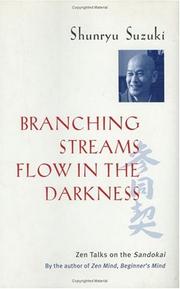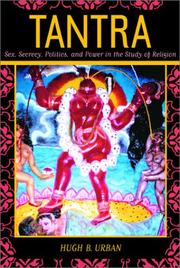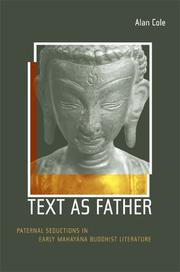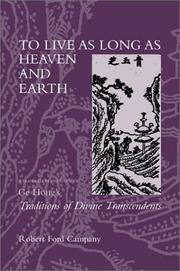| Listing 1 - 10 of 13 | << page >> |
Sort by
|

ISBN: 1282759418 9786612759413 0520932315 1598759167 9780520932319 1423745515 9781423745518 0520246195 9780520246195 9780520246195 0520246195 9781282759411 6612759410 9781598759167 Year: 2006 Publisher: Berkeley University of California Press
Abstract | Keywords | Export | Availability | Bookmark
 Loading...
Loading...Choose an application
- Reference Manager
- EndNote
- RefWorks (Direct export to RefWorks)
This highly original, provocative, and poetic work explores the nexus of time, truth, and death in the symbolic world of medieval kabbalah. Demonstrating that the historical and theoretical relationship between kabbalah and western philosophy is far more intimate and extensive than any previous scholar has ever suggested, Elliot R. Wolfson draws an extraordinary range of thinkers such as Frederic Jameson, Martin Heidegger, Franz Rosenzweig, William Blake, Julia Kristeva, Friedrich Schelling, and a host of kabbalistic figures into deep conversation with one another. Alef, Mem, Tau also discusses Islamic mysticism and Buddhist thought in relation to the Jewish esoteric tradition as it opens the possibility of a temporal triumph of temporality and the conquering of time through time. The framework for Wolfson's examination is the rabbinic teaching that the word emet, "truth," comprises the first, middle, and last letters of the Hebrew alphabet, alef, mem, and tau, which serve, in turn, as semiotic signposts for the three tenses of time-past, present, and future. By heeding the letters of emet we discern the truth of time manifestly concealed in the time of truth, the beginning that cannot begin if it is to be the beginning, the middle that re/marks the place of origin and destiny, and the end that is the figuration of the impossible disclosing the impossibility of figuration, the finitude of death that facilitates the possibility of rebirth. The time of death does not mark the death of time, but time immortal, the moment of truth that bestows on the truth of the moment an endless beginning of a beginningless end, the truth of death encountered incessantly in retracing steps of time yet to be taken-between, before, beyond.
Cabala --- Time --- History. --- Religious aspects --- Judaism. --- Philosophy. --- aqiva. --- azriel of gerona. --- azriel. --- babylonian talmud. --- bahir. --- bahiric text. --- berakhah. --- bereshit. --- binah. --- buddhism. --- death. --- destiny. --- eastern philosophy. --- eastern religion. --- emet. --- esoteric religion. --- immortality. --- islam. --- judaica. --- judaism. --- kabbalah. --- kabbalism. --- medieval kabbalah. --- mysticism. --- nature of time. --- philosophy. --- rebirth. --- religion. --- religious studies. --- semiotics. --- temporality. --- time. --- western philosophy. --- yiddishkeit.

ISBN: 052093623X 1280095008 1597345105 9786613520432 9780520936232 0520219821 9780520219823 9781280095009 9781597345101 6613520438 Year: 1999 Publisher: Berkeley University of California Press
Abstract | Keywords | Export | Availability | Bookmark
 Loading...
Loading...Choose an application
- Reference Manager
- EndNote
- RefWorks (Direct export to RefWorks)
When Shunryu Suzuki Roshi's Zen Mind, Beginner's Mind was published in 1972, it was enthusiastically embraced by Westerners eager for spiritual insight and knowledge of Zen. The book became the most successful treatise on Buddhism in English, selling more than one million copies to date. Branching Streams Flow in the Darkness is the first follow-up volume to Suzuki Roshi's important work. Like Zen Mind, Beginner's Mind, it is a collection of lectures that reveal the insight, humor, and intimacy with Zen that made Suzuki Roshi so influential as a teacher. The Sandokai-a poem by the eighth-century Zen master Sekito Kisen (Ch. Shitou Xiqian)-is the subject of these lectures. Given in 1970 at Tassajara Zen Mountain Center, the lectures are an example of a Zen teacher in his prime elucidating a venerated, ancient, and difficult work to his Western students. The poem addresses the question of how the oneness of things and the multiplicity of things coexist (or, as Suzuki Roshi expresses it, "things-as-it-is"). Included with the lectures are his students' questions and his direct answers to them, along with a meditation instruction. Suzuki Roshi's teachings are valuable not only for those with a general interest in Buddhism but also for students of Zen practice wanting an example of how a modern master in the Japanese Soto Zen tradition understands this core text today.
Zen Buddhism --- Doctrines. --- Sekito Kisen --- Kisen, Sekito --- 1970. --- beauty. --- buddhism. --- buddhist poetry. --- buddhist teachings. --- buddhists. --- collection of lectures. --- eastern philosophy. --- japan. --- japanese buddhism. --- life journey. --- meditation instructions. --- modern buddhism. --- nonfiction. --- oneness. --- philosophy. --- question and answer. --- religious treatise. --- sandokai. --- soto zen tradition. --- spiritual insight. --- spiritualism. --- spirituality and religion. --- students and teachers. --- western students. --- world religions. --- zen buddhism. --- zen masters. --- zen practices. --- zen teachers. --- zen.
Book
ISBN: 1283291770 9786613291776 0520948181 9780520948181 9780520266988 Year: 2011 Publisher: Berkeley University of California Press
Abstract | Keywords | Export | Availability | Bookmark
 Loading...
Loading...Choose an application
- Reference Manager
- EndNote
- RefWorks (Direct export to RefWorks)
A foundation of Chinese life sciences and medicine, the Huang Di Nei Jing Su Wen is now available for the first time in a complete, fully annotated English translation. Also known as Su Wen, or The Yellow Emperor's Inner Classic, this influential work came into being over a long period reaching from the 2nd century bce to the 8th century ce. Combining the views of different schools, it relies exclusively on natural law as conceptualized in yin/yang and Five Agents doctrines to define health and disease, and repeatedly emphasizes personal responsibility for the length and quality of one's life. This two-volume edition includes excerpts from all the major commentaries on the Su Wen, and extensive annotation drawn from hundreds of monographs and articles by Chinese and Japanese authors produced over the past 1600 years and into the twentieth century.
Medicine, Chinese --- Su wen. --- alternative medicine. --- character. --- chinese literature. --- chinese medicine. --- chinese tradition. --- classical chinese medicine. --- disease prevention. --- disease. --- eastern medicine. --- eastern philosophy. --- five agents. --- health and wellness. --- health. --- healthcare. --- huang di nei jing su wen. --- hygiene. --- medicine. --- nonfiction. --- su wen. --- yellow emperor. --- yellow emperors inner classic. --- yin yang.

ISBN: 1282359614 1597349321 9786612359613 9781417525533 0520936892 9780520936898 1417525533 9781417525539 9781597349321 6612359617 0520230620 9780520230620 0520236564 9780520236561 9781282359611 Year: 2003 Publisher: Berkeley University of California Press
Abstract | Keywords | Export | Availability | Bookmark
 Loading...
Loading...Choose an application
- Reference Manager
- EndNote
- RefWorks (Direct export to RefWorks)
A complex body of religious practices that spread throughout the Hindu, Buddhist, and Jain traditions; a form of spirituality that seemingly combines sexuality, sensual pleasure, and the full range of physical experience with the religious life-Tantra has held a central yet conflicted role within the Western imagination ever since the first "discovery" of Indian religions by European scholars. Always radical, always extremely Other, Tantra has proven a key factor in the imagining of India. This book offers a critical account of how the phenomenon has come to be. Tracing the complex genealogy of Tantra as a category within the history of religions, Hugh B. Urban reveals how it has been formed through the interplay of popular and scholarly imaginations. Tantra emerges as a product of mirroring and misrepresentation at work between East and West--a dialectical category born out of the ongoing play between Western and Indian minds. Combining historical detail, textual analysis, popular cultural phenomena, and critical theory, this book shows Tantra as a shifting amalgam of fantasies, fears, and wish-fulfillment, at once native and Other, that strikes at the very heart of our constructions of the exotic Orient and the contemporary West.
Tantric Buddhism. --- Tantrism. --- Buddhism, Tantric --- Buddhist tantrism --- Esoteric Buddhism --- Mantrayāna Buddhism --- Mikkyō --- Tantrism, Buddhist --- Vajrayāna Buddhism --- Buddhism --- Mahayana Buddhism --- Tantricism --- Tantrism, Hindu --- Hinduism --- Magic --- Mysticism --- anthropology. --- buddhism. --- buddhist tradition. --- comparative religion. --- contemporary religion. --- critical theory. --- cultural phenomena. --- east and west. --- eastern philosophy. --- european scholars. --- faith and spirituality. --- hinduism. --- india. --- indian religions. --- jainism. --- nonfiction. --- physical experiences. --- political power. --- religious lives. --- religious practices. --- religious secrecy. --- religious studies. --- sensuality. --- sex. --- sexual politics. --- sexuality. --- tantra. --- western thought. --- western world. --- world religions.

ISBN: 9786612357589 0520931408 1282357581 1598755412 9780520931404 1417595876 9781417595877 9781598755411 9780520242760 0520242769 9781282357587 6612357584 Year: 2005 Publisher: Berkeley Los Angels University of California Press
Abstract | Keywords | Export | Availability | Bookmark
 Loading...
Loading...Choose an application
- Reference Manager
- EndNote
- RefWorks (Direct export to RefWorks)
This beautifully written work sheds new light on the origins and nature of Mahayana Buddhism with close readings of four well-known texts-the Lotus Sutra, Diamond Sutra, Tathagatagarbha Sutra, and Vimalakirtinirdesa. Treating these sutras as literary works rather than as straightforward philosophic or doctrinal treatises, Alan Cole argues that these writings were carefully sculpted to undermine traditional monastic Buddhism and to gain legitimacy and authority for Mahayana Buddhism as it was veering away from Buddhism's older oral and institutional forms. His sophisticated and sustained analysis of the narrative structures and seductive literary strategies used in these sutras suggests that they were specifically written to encourage devotion to the written word instead of other forms of authority, be they human, institutional, or iconic.
Mahayana Buddhism --- Paternalism --- Parentalism --- Social classes --- Social control --- Social systems --- Doctrines. --- Religious aspects --- Mahayana Buddhism. --- Sacred books. --- Mahayana Buddhism - Sacred books. --- Paternalism - Religious aspects - Mahayana Buddhism. --- Mahayana Buddhism - Doctrines. --- asian. --- buddhism. --- buddhist books. --- buddhist monk. --- buddhist studies. --- china. --- chinese buddhism. --- diamond sutra. --- eastern philosophy. --- eastern religion. --- lotus sutra. --- mahayana. --- meditation. --- mindfulness. --- monastic buddhism. --- monasticism. --- monk. --- nonfiction. --- philosophy. --- religion. --- spirituality. --- sutra studies. --- sutra. --- sutras. --- tathagatagarbha sutra. --- vimalakirti nirdesa.

ISBN: 1283277026 9786613277022 0520927605 1597349593 9780520927605 1417523875 9781417523870 9781597349598 9780520230347 0520230345 Year: 2002 Publisher: Berkeley University of California Press
Abstract | Keywords | Export | Availability | Bookmark
 Loading...
Loading...Choose an application
- Reference Manager
- EndNote
- RefWorks (Direct export to RefWorks)
In late classical and early medieval China, ascetics strove to become transcendents--deathless beings with supernormal powers. Practitioners developed dietetic, alchemical, meditative, gymnastic, sexual, and medicinal disciplines (some of which are still practiced today) to perfect themselves and thus transcend death. Narratives of their achievements circulated widely. Ge Hong (283-343 C.E..) collected and preserved many of their stories in his Traditions of Divine Transcendents, affording us a window onto this extraordinary response to human mortality. Robert Ford Company's groundbreaking and carefully researched text offers the first complete, critical translation and commentary for this important Chinese religious work, at the same time establishing a method for reconstructing lost texts from medieval China. Clear, exacting, and annotated, the translation comprises over a hundred lively, engaging narratives of individuals deemed to have fought death and won. Additionally, To Live as Long as Heaven and Earth systematically introduces the Chinese quest for transcendence, illuminating a poorly understood tradition that was an important source of Daoist religion and a major social, cultural, and religious phenomenon in its own right.
Taoists --- Ge, Hong, --- Taoists - China - Biography --- Ge, Hong, - 284-364. - Shen xian zhuan --- alchemy. --- ancient china. --- archival work. --- ascetics. --- buddhism. --- china. --- chinese history. --- chinese texts. --- classicism. --- daoism. --- discipline. --- divinity. --- eastern philosophy. --- gymnastics. --- immortals. --- lost texts. --- medicine. --- medieval china. --- meditation. --- mortality. --- nonfiction. --- paranormal. --- philosophy. --- religion. --- sexual discipline. --- sexual practices. --- spirituality. --- supernatural being. --- supernatural powers. --- supernatural. --- taoism. --- to live as long as heaven and earth. --- traditions of the divine transcendents. --- transcend death. --- transcendents. --- transfiguration.
Book
ISBN: 0520965833 9780520965836 9780520292277 0520292278 Year: 2016 Publisher: Oakland, California
Abstract | Keywords | Export | Availability | Bookmark
 Loading...
Loading...Choose an application
- Reference Manager
- EndNote
- RefWorks (Direct export to RefWorks)
This newly revised and updated edition of Paul U. Unschuld's original 1986 groundbreaking translation reflects the latest philological, methodological, and sinological standards of the past thirty years. The Nan Jing was compiled in China during the first century C.E., marking both an apex and a conclusion to the initial development stages of Chinese medicine. Based on the doctrines of the Five Phases and yinyang, the Nan Jing covers all aspects of theoretical and practical health care in an unusually systematic fashion. Most important is its innovative discussion of pulse diagnosis and needle treatment. This new edition also includes selected commentaries by twenty Chinese and Japanese authors from the past seventeen centuries. The commentaries provide insights into the processes of reception and transmission of ancient Chinese concepts from the Han era to the present time. Together with the Huang Di Nei Jing Su Wen and the Huang Di Nei Jing Ling Shu, this new translation of the Nan Jing constitutes a trilogy of writings offering scholars and practitioners today unprecedented insights into the beginnings of a two-millennium tradition of what was a revolutionary understanding of human physiology and pathology.
Medicine, Chinese --- Bianque, --- Pien-chʻüeh, --- Nan jing (Bianque) --- Huang di ba shi yi nan jing (Bianque) --- Nan ching (Pien-chʻüeh) --- 1986. --- academic research. --- academic. --- ancient china. --- ancient world. --- anthology. --- china. --- chinese culture. --- chinese medicine. --- chinese translation. --- doctrine. --- eastern medicine. --- eastern philosophy. --- essays. --- first century. --- five phases. --- han era. --- health care. --- medical professional. --- medical text. --- medical texts. --- methodology. --- modern world. --- nan jing. --- needles. --- pathology. --- philosophy. --- physiology. --- practical. --- pulse. --- research. --- revised. --- scholarly. --- translation. --- updated. --- yinyang.
Book
ISBN: 0520959620 9780520959620 9780520268937 0520268938 Year: 2015 Publisher: Berkeley
Abstract | Keywords | Export | Availability | Bookmark
 Loading...
Loading...Choose an application
- Reference Manager
- EndNote
- RefWorks (Direct export to RefWorks)
Daisetsu Teitaro Suzuki was a key figure in the introduction of Buddhism to the non-Asian world. Many outside Japan encountered Buddhism for the first time through his writings and teaching, and for nearly a century his work and legacy have contributed to the ongoing religious and cultural interchange between Japan and the rest of the world, particularly the United States and Europe. This second volume of Selected Works of D. T. Suzuki brings together Suzuki's writings on Pure Land Buddhism. At the center of the Pure Land tradition is the Buddha Amida and his miraculous realm known as paradise or "the land of bliss," where sentient beings should aspire to be born in their next life and where liberation and enlightenment are assured. Suzuki, by highlighting certain themes in Pure Land Buddhism and deemphasizing others, shifted its focus from a future, otherworldly goal to religious experience in the present, wherein one realizes the nonduality between the Buddha and oneself and between paradise and this world. An introduction by James C. Dobbins analyzes Suzuki's cogent, distinctive, and thought-provoking interpretations, which helped stimulate new understandings of Pure Land Buddhism quite different from traditional doctrine.
Zen Buddhism. --- Chʻan Buddhism --- Dhyāna (Sect) --- Zen --- Zen (Sect) --- Buddhism --- Mahayana Buddhism --- Suzuki, Daisetz Teitaro, --- Suzuki, Daisetsu --- Suzuki, D.T. --- 鈴木大拙貞太郎 --- 鈴木貞太郎 --- buddha amida. --- buddhism. --- buddhist sacred writings. --- chan. --- daisetsu teitaro suzuki. --- dt suzuki. --- enlightenment. --- far eastern philosophy. --- infinite light. --- japan. --- japanese author. --- japanese spirituality. --- koan exercise. --- liberation. --- myokonin. --- non asian world. --- otherworldly goal. --- paradise. --- philosophy. --- pure land buddhism. --- religion. --- religious doctrine. --- religious teachings. --- retrospective. --- shin. --- shinran shonin. --- spiritual. --- spirituality. --- teachings. --- the land of bliss. --- thought provoking. --- traditional doctrine. --- zen.
Book
ISBN: 0520959612 9780520959613 0520269195 9780520269194 9780520268937 Year: 2015 Publisher: Oakland, California
Abstract | Keywords | Export | Availability | Bookmark
 Loading...
Loading...Choose an application
- Reference Manager
- EndNote
- RefWorks (Direct export to RefWorks)
Daisetsu Teitaro Suzuki was a key figure in the introduction of Buddhism to the non-Asian world. Many outside of Japan encountered Buddhism for the first time through his writings and teaching, and for nearly a century his work and legacy have contributed to the ongoing religious and cultural interchange between Japan and the rest of the world, particularly the United States and Europe. Selected Works of D. T. Suzuki gathers the full range of Suzuki's writings-both classic essays and lesser-known but equally significant articles. This first volume in the series presents a collection of Suzuki's writings on Zen Buddhist thought and practice. In an effort to ensure the continued relevance of Zen, Suzuki drew on his years of study and practice, placing the tradition into conversation with key trends in nineteenth- and twentieth-century thought. Richard M. Jaffe's in-depth introduction situates Suzuki's approach to Zen in the context of modern developments in religious thought, practice, and scholarship. The romanization of Buddhist names and technical terms has been updated, and Chinese and Japanese characters, which were removed from many post-World War II editions of Suzuki's work, have been reinstated. This will be a valuable edition of Suzuki's writings for contemporary scholars and students of Buddhism.
Zen Buddhism. --- Chʻan Buddhism --- Dhyāna (Sect) --- Zen --- Zen (Sect) --- Buddhism --- Mahayana Buddhism --- Suzuki, Daisetz Teitaro, --- Suzuki, Daisetsu --- Suzuki, D.T. --- 鈴木大拙貞太郎 --- 鈴木貞太郎 --- 19th century japanese thought. --- 20th century japanese thought. --- asian religions. --- asian religious thought. --- buddha. --- buddhism. --- chan. --- daisetsu teitaro suzuki. --- dt suzuki. --- far eastern philosophy. --- japan. --- japanese religion. --- japanese zen. --- japanese. --- legacy. --- major world religion. --- meditation. --- religion studies. --- religion. --- religious studies. --- religious teachings. --- shin. --- siddhartha gautama. --- spiritual practices. --- spirituality. --- writings and teachings. --- zen buddhism. --- zen.
Book
ISBN: 9780520965355 0520965353 9780520269170 0520269179 Year: 2016 Publisher: Oakland, California
Abstract | Keywords | Export | Availability | Bookmark
 Loading...
Loading...Choose an application
- Reference Manager
- EndNote
- RefWorks (Direct export to RefWorks)
Daisetsu Teitaro Suzuki was a key figure in the introduction of Buddhism to the non-Asian world. Many outside Japan encountered Buddhism for the first time through his writings and teaching, and for nearly a century his work and legacy have contributed to the ongoing religious and cultural interchange between Japan and the rest of the world, particularly the United States and Europe. This third volume of Selected Works of D. T. Suzuki brings together a diverse collection of Suzuki's letters, essays, and lectures about non-Buddhist religions and his thoughts on their relation to Buddhism, as well as his reflections on the nature of religion itself. Some of these writings have been translated into English for the first time in this volume. As a long-term resident of the United States, a world traveler, and a voracious consumer of information about all forms of religion, Suzuki was one of the foremost Japanese mediators of Eastern and Western religious cultures for nearly seven decades. An introduction by Jeff Wilson and Tomoe Moriya analyzes Suzuki's frequent encounters with texts and practitioners of many religions, considers how events in Suzuki's lifetime affected his interpretations of Christianity, Shinto, and other traditions, and demonstrates that his legacy as a scholar extends well beyond Buddhism.
Zen Buddhism. --- Chʻan Buddhism --- Dhyāna (Sect) --- Zen --- Zen (Sect) --- Buddhism --- Mahayana Buddhism --- Suzuki, Daisetz Teitaro, --- Suzuki, Daisetsu --- Suzuki, D.T. --- 鈴木大拙貞太郎 --- 鈴木貞太郎 --- academic. --- anthology. --- asia. --- buddhism. --- buddhist. --- christianity. --- collected works. --- culture. --- eastern philosophy. --- eastern religion. --- essays. --- japan. --- japanese buddhism. --- japanese buddhist. --- japanese culture. --- lectures. --- legacy. --- letters. --- mediators. --- religion. --- religious figure. --- religious philosophy. --- scholar. --- selected works. --- shinto. --- single author. --- tradition. --- western culture. --- western religion. --- western world. --- world religion.
| Listing 1 - 10 of 13 | << page >> |
Sort by
|

 Search
Search Feedback
Feedback About UniCat
About UniCat  Help
Help News
News